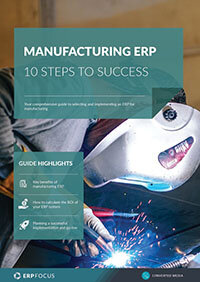3 Ways Manufacturing ERP Can Improve Supplier Management
Supply chain management and supplier management are important components of today’s ERP systems. Gone are the days when suppliers were antagonists who played zero-sum games with our interests. The concept of supply chain recognizes that all the businesses involved in satisfying the final user of any SKU will benefit from a high degree of cooperation, cooperation driven by our manufacturing ERP systems.
Define and Document the Criteria You Will Use to Manage Suppliers
These criteria will be different for each of our businesses. You may want three or more suppliers for any item. You may only want to deal with blue-chip businesses. You may search around the world for the lowest possible cost supplier. Record your criteria along with notes explaining why that measure was agreed upon and how it should be monitored within your manufacturing ERP system going forward.
Monitor Supplier Performance
Manufacturing ERP systems record every transaction. The exact date, time, quantity, and individual who made the transaction are tracked automatically. Your ERP analytics tools should include the creation of user dashboards and other data visibility tools. Use those tools to set up alerts when any supply chain metrics fall outside the agreed upon boundaries.
Recommended Reading: Process Manufacturing ERP Selection: 7 Steps to Success
The alert can be as simple as an automatic email to the purchasing manager when stock is low. This workflow can be improved further by integrating with your supplier’s systems. When your purchasing manager receives their alert, your sales contact at the supplier will also receive the alert, allowing them to begin the order process. They are your supply chain partner and should be treated as a systems partner also.
Use Audits to Build Your Supplier Relationship
Keep your supplier criteria up to date with audits in person or remotely. This can be simply completing a questionnaire or as complex as an on-site visit with hundreds of process measurements. But don’t stop with merely checking facts and making measurements. Use the opportunity for extended communications with your suppliers. Can their ERP transmit real-time order status reports to your manufacturing ERP? You have installed lean processes and use your ERP to help you stay lean. Could your supplier benefit from your knowledge and use their ERP to improve their supply processes? Would a system integration between your businesses help you to see your incoming supply and help them to see your upcoming demand?
Don’t forget these points apply to your entire supply chain. The business on which you place a purchase order is obviously part of the chain. Other parts include transportation carriers and distribution businesses you might not have a direct financial relationship with. If they are part of your chain, you should manage your relationship with them using your manufacturing ERP. Your suppliers may be global, but with well implemented ERP integrations, they will feel like your next-door neighbours.
Free white paper

Manufacturing ERP: 10 steps to success
Complete step-by-step guide to manufacturing ERP software

Featured white papers
-

Manufacturing ERP: 10 steps to success
Complete step-by-step guide to manufacturing ERP software
Download -

Manufacturing ERP Implementation Checklist
Over 70 actionable steps to rolling out new manufacturing ERP software
Download -

7 steps to selecting distribution ERP
Get expert advice on distribution ERP selection and requirements analysis
Download
Related articles
-

4 training tips for manufacturing ERP success
These four training tips will help your employees get the most out of your new manufacturing ERP ...
-

Secret KPI: Why Your ERP Implementation Team Matters More Than Software
Learn how Godlan ensures successful ERP implementation for manufacturers with proven strategies &...
-

ERP for make-to-order manufacturing
How can ERP help your make-to-order manufacturing business thrive?

